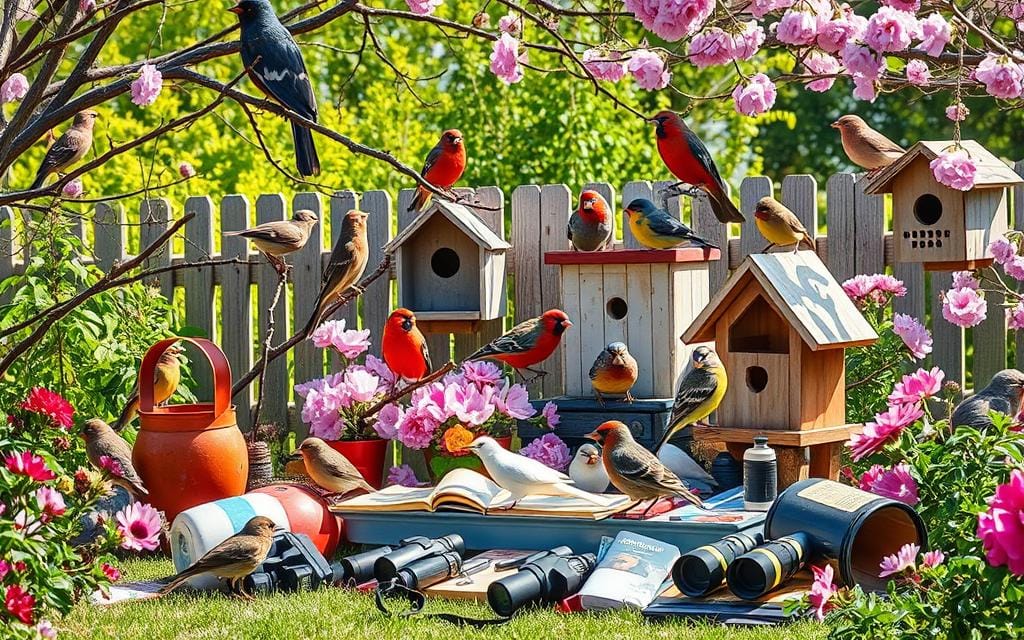As gardeners, we know that the right amount of sunlight is key for marigolds to grow well and bloom beautifully. Marigold sunlight requirements change with each type, but knowing their basic needs helps us create the best environment for them.
This guide will cover the sunlight needs for marigolds. We’ll talk about how sunlight is crucial for their growth and how to fix any sunlight problems. By the end, you’ll know the ideal sunlight for marigolds and how to make sure your marigold growth and sunlight work together perfectly.
Table of Contents
ToggleThe Importance of Sunlight for Marigold Growth
Sunlight is key for marigolds to grow well. They love being in the sun because it helps them grow and makes food through photosynthesis.
Understanding Marigolds’ Natural Habitat
Marigolds come from warm, sunny places like Mexico and the southwestern United States. They grow best in areas that get lots of sunlight all day. This sunlight is crucial for their health and growth.
The Role of Sunlight in Photosynthesis
Photosynthesis turns sunlight, carbon dioxide, and water into food for plants. Marigold sunlight needs are tied to this process. The more sun they get, the better they make food and grow.
Without enough photosynthesis in marigolds, they wouldn’t grow well. Knowing how sunlight helps marigolds is key to making them thrive.
Marigold Sunlight Requirements
Marigolds need a lot of sunlight to grow well. They love bright, direct sunlight. Knowing how much sunlight they need is key for their growth.
Marigolds should get at least 6 hours of direct sunlight each day. Even better is 8-10 hours. If they don’t get enough sun, they might grow tall and weak with fewer flowers.
Marigolds come from sunny places like Mexico and Central America. They’re used to lots of sunlight all day. So, planting them in full sun is best.
Right sunlight helps marigolds make food through photosynthesis. This is important for their health and growth. Also, more sunlight means the plants make more essential oils. This makes the flowers smell stronger and look more vibrant.
Make sure your marigolds get enough sunlight by picking a spot without shadows from buildings or trees. Move them if needed to get 6-10 hours of sunlight each day.
Signs of Too Little or Too Much Sunlight
Finding the right balance between sunlight and shade is key for marigolds to grow well. Too little or too much sun can cause stress symptoms that affect their health and look. Let’s look at the signs to watch for.
Identifying Sunlight Deficiency Symptoms
Marigolds show stress signs if they don’t get enough sunlight. These include:
- Leggy, elongated stems as the plant stretches to reach for more light
- Pale, yellowing leaves as chlorophyll production decreases
- Reduced flower production or smaller blooms
- Increased susceptibility to pests and diseases
Not enough sunlight makes leaves thin and not green like healthy marigolds. This shows the plant is struggling with photosynthesis.
Identifying Sunlight Excess Symptoms
Marigolds can also show stress if they get too much sun. Signs include:
- Wilting or curling leaves as the plant tries to conserve moisture
- Discoloration, such as leaves turning pale or developing brown spots
- Stunted growth and smaller, fewer flowers
- Increased susceptibility to diseases like powdery mildew
Too much sun can dry out the plant, making it look stressed and unhealthy. Watching and adjusting the sunlight is important for marigolds to do well.
Ideal Sunlight Exposure for Different Marigold Varieties
Not all marigolds need the same amount of sunlight. Each type has its own sunlight needs. Knowing these needs helps your marigolds grow well. Let’s look at the best sunlight for tall and dwarf marigolds.
Sunlight Needs of Tall Marigold Varieties
Tall marigolds like ‘African Marigold’ and ‘Crackerjack Marigold’ need lots of sunlight. They do best with 6 to 8 hours of direct sunlight daily. If they’re in the shade, they might grow weak and produce fewer flowers.
Sunlight Needs of Dwarf Marigold Varieties
Dwarf marigolds, such as ‘Petite Marigold’ and ‘Naughty Marietta’, don’t need as much sunlight. They do well with 4 to 6 hours of direct sunlight. These plants are perfect for shady spots or small gardens. But, they still like as much sunlight as they can get.
| Marigold Variety | Sunlight Needs |
|---|---|
| Tall Marigolds | 6-8 hours of direct sunlight per day |
| Dwarf Marigolds | 4-6 hours of direct sunlight per day |
Knowing what sunlight each marigold type needs helps gardeners give them the right amount of light. This ensures they grow well and bloom beautifully.
How Much Sunlight Do Marigolds Need?
Marigolds are bright and cheerful flowers that make any garden more colorful. They need the right amount of sunlight to grow and bloom well. Knowing how much sunlight marigolds need is key to making them thrive in your garden.
Marigolds love full sun, needing at least 6 hours of direct sunlight every day. The more sunlight they get, the better they grow. But, the exact sunlight needs can change based on the marigold type you grow.
| Marigold Variety | Optimal Sunlight Requirement |
|---|---|
| Tall Marigolds | 6-8 hours of direct sunlight per day |
| Dwarf Marigolds | 6-10 hours of direct sunlight per day |
Marigolds can handle some shade, but they won’t bloom as much or have as bright colors in the shade. Finding the right balance of sunlight is crucial for their growth and beauty.

Knowing how much sunlight marigolds need helps you create the best environment for them. With enough sunlight, your marigolds will give you a beautiful show of color all season.
Maximizing Sunlight Exposure for Optimal Growth
Gardeners know how crucial it is to give our marigolds enough sunlight for great growth and bright flowers. By picking the perfect spot to plant, we make sure our marigolds get the sunlight they need to flourish.
Choosing the Right Planting Location
For marigolds, where you plant them matters a lot. They love full sun, needing at least 6 hours of direct sunlight each day. Here are some tips to get them the most sunlight:
- Pick a spot in your garden that gets lots of sun, ideally for at least 6 hours a day.
- Don’t put marigolds in shady spots or under big plants, as they won’t get enough light.
- Face your marigold bed or containers south or west, as these get the most sunlight.
- If space is tight, grow marigolds in containers and put them in the sunniest parts of your yard.
By picking the right spot and making sure your marigolds get enough marigold sunlight exposure, you’ll have a beautiful marigold garden. It will make your outdoor area more joyful and lovely.
Adjusting Sunlight Levels Throughout the Growing Season
Marigolds change their sunlight needs as they grow. It’s important to adjust sunlight levels with the season for the best growth and blooms.
In the early stages, marigolds need more sunlight to grow strong. Later, some types prefer less sun in the summer heat.
Watch how your marigolds act and change their sunlight levels as needed. Here are tips for managing sunlight by season:
- Spring: Give your marigolds full sun for at least 6 hours a day.
- Summer: Use partial shade in the middle of the day for tall marigolds to prevent damage.
- Fall: Increase sunlight as days get shorter to keep them blooming.
Adjusting sunlight helps marigolds thrive and look great in your garden.
| Season | Sunlight Needs |
|---|---|
| Spring | Full sun (at least 6 hours per day) |
| Summer | Partial shade during midday |
| Fall | Increased sunlight exposure |
Sunlight and Other Environmental Factors
Sunlight is key for marigolds, but it’s not the only thing that matters. Temperature and humidity also play big roles in how well these flowers grow and stay healthy. Let’s see how these elements work with sunlight to affect marigolds.
The Role of Temperature and Humidity
Marigolds love warm, well-drained spots. They do best in temperatures between 70-85°F (21-29°C). If the temperature goes too high or too low, they can get stressed and grow poorly.
Humidity matters too. Marigolds like it when the air is a bit moist, between 40-70%. Too dry or too wet can cause problems like wilting, mold, or root rot.
| Environmental Factor | Optimal Range for Marigolds | Potential Issues Outside the Optimal Range |
|---|---|---|
| Sunlight | 6-8 hours of direct sunlight per day | Insufficient or excessive sunlight can lead to stunted growth, poor flowering, or foliage discoloration |
| Temperature | 70-85°F (21-29°C) | Temperatures outside this range can cause stress, stunted growth, and reduced flowering |
| Humidity | 40-70% | Excessively dry or wet conditions can lead to wilting, mold, or root rot |
Knowing how sunlight, temperature, and humidity work together helps gardeners make the best environment for marigolds. This way, they can enjoy beautiful, healthy flowers all season long.
Common Sunlight-Related Issues and Solutions
As gardeners, we know that marigolds need the right sunlight to stay healthy and strong. But sometimes, we face problems with sunlight that can hurt their growth and look. Let’s look at common issues and how to fix them to keep our marigolds doing well.
Sunburn
Sunburn on marigolds shows up as discolored leaves and wilting petals. It can even harm the plant’s tissues. To stop sunburn, we can:
- Put the plants in a spot that gets some shade, away from too much direct sunlight.
- Use shade cloth or other covers to soften the sunlight and make it less intense.
- Water the plants often to keep them hydrated and strong against the sun.
Etiolation
Not enough sunlight can cause etiolation, making marigolds look tall and weak with pale, yellow leaves. To fix this, we should:
- Move the marigolds to a spot that gets more direct sunlight, for at least 6 hours a day.
- Think about using grow lights as extra lighting for better growth.
- Make sure nothing is blocking the plants from getting sunlight.
Other Sunlight-Related Problems
Marigolds can also have issues like fewer flowers, slow growth, and a different smell if the sunlight isn’t right. To solve these problems, we can:
- Watch the plants and move them to a better spot if needed, or give them some shade.
- Think about the type of marigold you have and its sunlight needs. Some can handle shade better than others.
- Keep watering the plants regularly to help them adjust to changes in sunlight.
By knowing about sunlight problems and how to fix them, we can make sure our marigolds stay healthy and bright all season.
Complementing Sunlight with Artificial Lighting
When natural sunlight is scarce, we can use artificial lighting like grow lights to help our marigolds. This ensures they get enough light to grow well, even in tough outdoor spots.
Using Grow Lights for Marigolds
Grow lights are great for marigold growers who struggle with sunlight. By placing these lights right, we can give our marigolds the extra light they need. This helps them grow strong and bloom well, whether indoors or in a shady spot.
Choosing the right grow lights for marigolds means looking at intensity, spectrum, and how long they last. Marigolds do best under full-spectrum light that’s similar to natural sunlight. By adjusting the grow lights, we can make a space that feels like the perfect sunny spot for these flowers.
FAQ
How much sunlight do marigolds need?
Marigolds love full sun, needing 6-8 hours of direct sunlight daily. They can handle some shade but grow and bloom less without enough sun.
What are the signs of too little or too much sunlight for marigolds?
Too little sun makes marigolds grow long and leafy, with fewer flowers. Too much sun can cause wilting, burned leaves, and stunted growth. We’ll look into these signs to help you fix sunlight issues.
Do different marigold varieties have varying sunlight needs?
Yes, different marigolds need different amounts of sun. Tall ones need lots of sun, while smaller ones can handle more shade. We’ll guide you on the best sun exposure for each type.
How can I maximize sunlight exposure for my marigolds?
Pick a spot that gets full sun most of the day for your marigolds. Use reflective materials or place them to get the right amount of sun and light.
How do I adjust sunlight levels for my marigolds as the season progresses?
Marigolds change their sun needs as they grow. We’ll show you how to watch and adjust their sunlight, like moving them or using shades, for the best growth.
Can I use artificial lighting to supplement natural sunlight for my marigolds?
Yes, grow lights or other artificial lighting can help your marigolds in low-sun areas. We’ll talk about the best ways to use artificial light for their growth.









